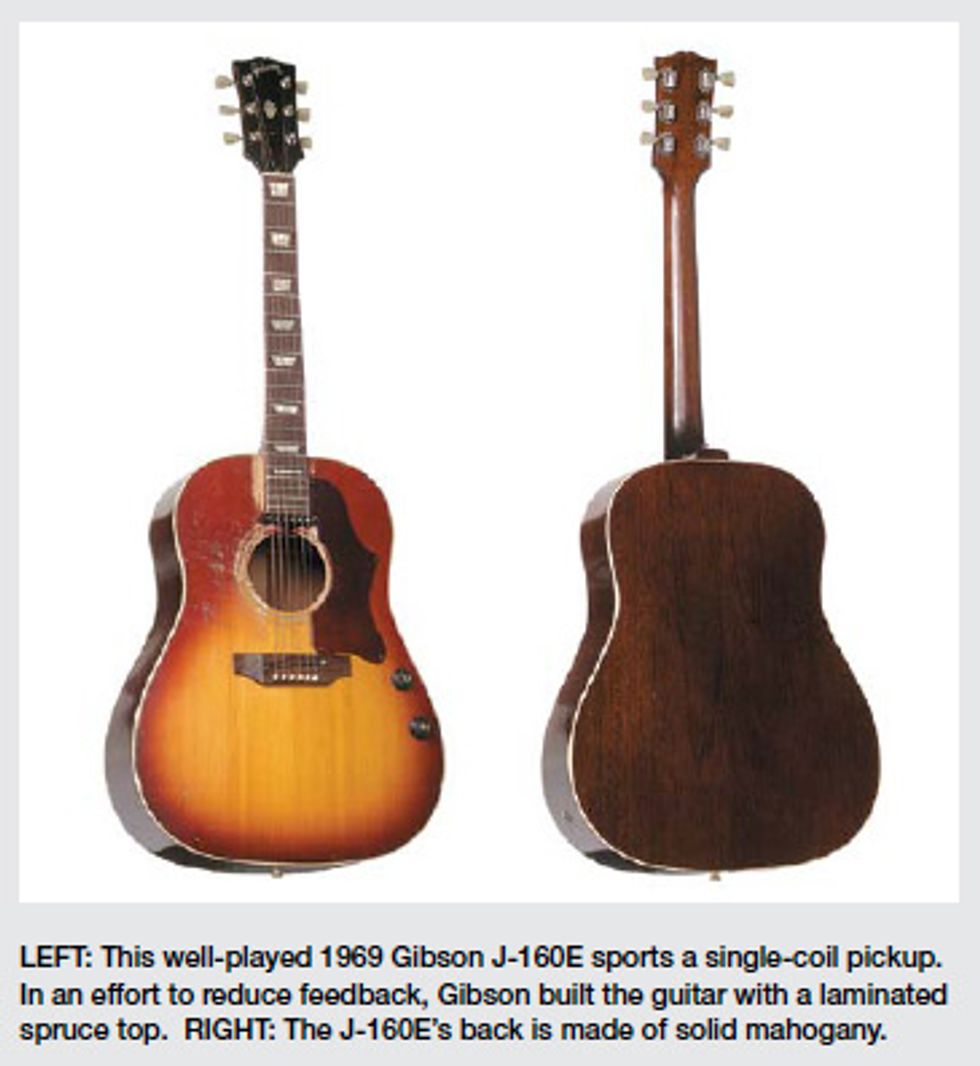Hey Zach,
I have a Gibson J-160E from the ’60s that has seen quite a bit
of playing over the years. The serial number is 8419XX, but it
doesn’t have the “Made in USA” stamp. Contrary to what many
players say, I think this guitar sounds great as an acoustic. Can
you give me a little history on the J-160E and what its value is
today? Also, I find it surprising that the J-160E is so popular, yet
I don’t hear much about early Martin acoustic electrics. Thanks!
—Mark in Denver, CO

Hey Mark,
“Isn’t it good, Norwegian wood?” Well, the guitar isn’t made of Norwegian wood, but the famous Beatles song off of Rubber Soul—as well as many others—was played on a J-160E during the mid ’60s. Gibson’s “jumbo flattop electric guitar” was one of the first acoustic/electric guitars to be mass-produced, and it was also one of John Lennon’s most played instruments.
Electrified guitars were the norm by the early ’50s, but a true flattop acoustic guitar with a pickup had yet to be produced. Gibson introduced the CF-100E in 1951, which was an electrified version of the CF-100, introduced shortly before. The CF-100E featured one single-coil pickup mounted at the bottom of the fretboard—a far cry in design from the acoustic/electric guitars of today. Both models had a small body and sharp Florentine cutaway, but were discontinued in 1958, as they were not very popular.
In 1954, Gibson launched an electrified version of their hugely popular Southern Jumbo (SJ) called the J-160E. Like the CF-100E, it had a single-coil pickup mounted right below the fretboard with electric-style Volume and Tone knobs mounted directly on the soundboard. The J-160E featured a 3-ply laminated spruce top (the earliest models in 1954 were solid), a solid mahogany back, laminated mahogany sides, and a neck that met the body at the 15th fret, allowing room for the pickup between the fretboard and soundhole.
While the J-160E was certainly a dual-purpose instrument, many collectors don’t realize that it was designed primarily as an electric that could be used as an acoustic. Piezo and internal pickups were years from being developed, so this is all Gibson knew at the time. The laminated top and ladder bracing were used intentionally to prevent unwanted frequencies and feedback. Also, because the neck was moved up to allow room for the pickup, the bridge had to be moved forward as well—so traditional X bracing wouldn’t work in this situation.
According to the serial number, your guitar dates from either 1966 or 1969. The long-style pickguard on your guitar was introduced in 1968, so we can safely assume your guitar is a 1969 model. This was probably one of the last J-160Es produced before Gibson switched to the square shoulder body style they adopted on nearly all their acoustics in the late ’60s and early ’70s. For whatever reason, the J-160E was always a bit late to adopt changes compared to other Gibson models. Everything appears to be stock on the guitar, including the bridge and control knobs.
This 1969 J-160E, in the condition it appears (which is 70 percent or “average”), is valued today between $1850 and $2250. If it were mint, it would be a $3000 to $3500 instrument. Astute readers will know that the J-160E is more valuable than an SJ produced during the same period. The J-160E ’s value is higher simply because of its association with the Beatles, and this is fairly typical of any guitar that a famous musician or band is known for using. Instrument association has affected every instrument the Beatles ever played, including Paul McCartney’s Höfner 500/1 “Beatle Bass,” John Lennon’s Rickenbacker 325 and Gibson J-160E, and George Harrison’s Rickenbacker 360 12-string.
So where does Martin fit into all of this, given they’re the granddaddy of American acoustic guitar builders? Four years after the J-160E hit the stores, Martin introduced their first acoustic/ electric flattop guitars with the D-18E and D-28E—electrified versions of the D-18 and D-28, respectively. Both variations featured two large DeArmond pickups and four knobs (one Volume and one Tone for each pickup) mounted on the soundboard. The construction of these guitars required ladder bracing similar to the J-160E, and the overall sound quality suffered because of it. Those who have seen these electric Martins know they were clunky, and large parts of the soundboard were removed for the pickups. Production of the D-18E lasted only two years and the D-28E was produced through 1964. There is little collector value with Martin’s first acoustic/ electrics—roughly half of the acoustic versions.
The J-160E will never replace any high-quality flattop acoustic in terms of sound, but as one of the first guitars to allow a player to use it acoustically and electrically, it succeeds wonderfully. Any guitar associated with the Beatles is a treasure in my book!
If you’re interested in exploring this subject further, check out Gibson’s Fabulous Flat-Top Guitars by Eldon Whitford, David Vinopal, and Dan Erlewine.
 Zachary R. Fjestad
is author of Blue Book of
Acoustic Guitars, Blue Book
of Electric Guitars, and Blue
Book of Guitar Amplifiers.
For more information, visit
bluebookinc.com or email
Zach at guitars@bluebookinc.com.
Zachary R. Fjestad
is author of Blue Book of
Acoustic Guitars, Blue Book
of Electric Guitars, and Blue
Book of Guitar Amplifiers.
For more information, visit
bluebookinc.com or email
Zach at guitars@bluebookinc.com.









![Rig Rundown: Russian Circles’ Mike Sullivan [2025]](https://www.premierguitar.com/media-library/youtube.jpg?id=62303631&width=1245&height=700&quality=70&coordinates=0%2C0%2C0%2C0)






